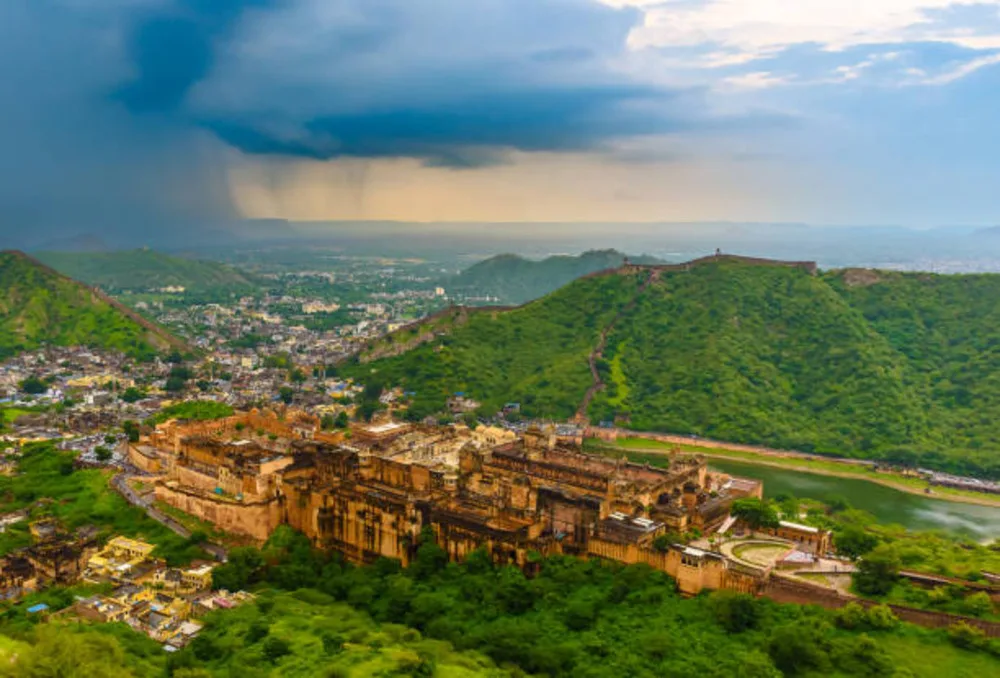Amber Fort in India, a majestic blend of Rajput and Mughal architecture, stands as a symbol of India’s rich royal heritage. Situated in Jaipur, Rajasthan, this UNESCO World Heritage Site captures the essence of regal elegance with its grand courtyards, stunning palaces, intricate carvings, and the panoramic views of Maota Lake. This travel guide will take you through the fascinating history, architecture, and must-visit spots within Amber Fort, ensuring an unforgettable journey into India’s royal past.
- Amber Fort in India: The Jewel of Rajasthan’s Architectural Mastery
- 1. Amber Fort in India: A Historical Overview
- 2. The Magnificent Architecture of Amber Fort in India
- 3. Experiencing the Beauty of Amber Fort: Must-Visit Attractions
- 4. Light and Sound Show at Amber Fort in India
- 5. Elephant Rides and Cultural Experiences at Amber Fort in India
- 6. Practical Travel Tips for Visiting Amber Fort in India
- 7. How to Reach Amber Fort in India
- Conclusion: Amber Fort in India – A Timeless Journey into Royal Grandeur
Amber Fort in India: The Jewel of Rajasthan’s Architectural Mastery
Amber Fort in India stands as the crown jewel of Rajasthan’s architectural brilliance, offering a captivating glimpse into India’s royal heritage. Its stunning blend of Mughal and Rajput styles, intricate mirror work, and grand courtyards reflect the rich legacy of royal craftsmanship. From the majestic Ganesh Pol, the iconic gateway adorned with vibrant frescoes, to the breathtaking Sheesh Mahal with its dazzling mirrors, Amber Fort in India showcases the regal beauty that has enchanted travelers for centuries. This historical marvel is a must-visit for anyone exploring Rajasthan, offering an unforgettable journey into the grandeur of India’s past.
1. Amber Fort in India: A Historical Overview
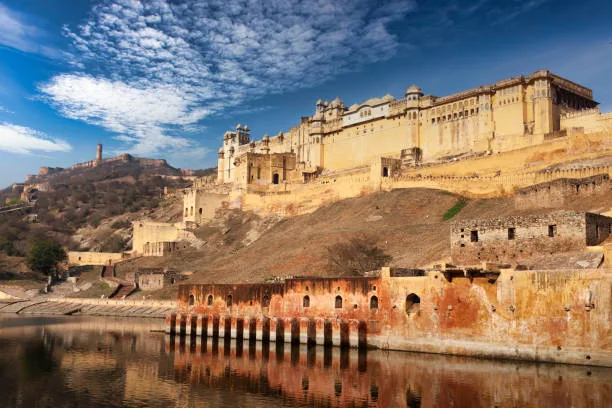
Amber Fort in India, also known as Amer Fort, was built in 1592 by Raja Man Singh I, a trusted general of Emperor Akbar. Constructed on the remnants of an ancient fort, Amber Fort showcases a perfect blend of Hindu and Mughal influences. Its towering walls and strategic location atop the Aravalli Hills made it an impregnable defense structure during times of conflict.
The fort served as the royal residence for the Rajput Maharajas and their families for over 150 years before the capital moved to Jaipur. Walking through Amber Fort is like stepping back in time to an era of kings, queens, and grandeur, with every corner telling stories of opulence, bravery, and artistic mastery.
2. The Magnificent Architecture of Amber Fort in India
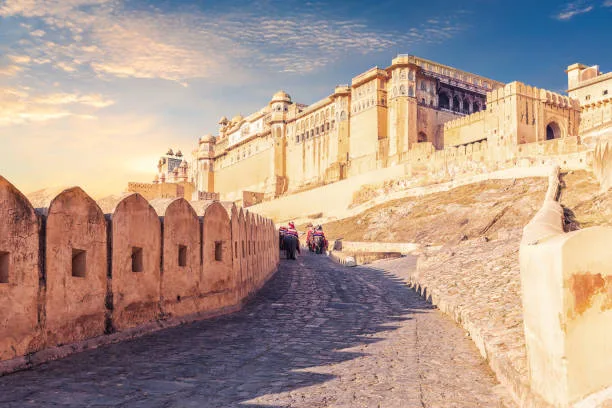
Amber Fort in India’s architecture is a stunning reflection of the artistic brilliance of its time, symbolizing the royal grandeur that Rajasthan is known for. The fort is divided into four main sections, each with its own courtyard, showcasing a harmonious blend of Mughal and Rajput styles. The combination of red sandstone and white marble creates a striking contrast, while the intricate carvings, murals, and mirror work add to the fort’s overall splendor. Amber Fort in India stands as a testament to the incredible craftsmanship and attention to detail that defines the country’s architectural heritage, making it a must-visit for anyone exploring India’s regal past.
Key Architectural Highlights:
- Ganesh Pol: The entrance gate to the private palaces, adorned with beautiful frescoes and murals.
- Diwan-i-Aam (Hall of Public Audience): Where the king met with his subjects, featuring towering pillars and ornate arches.
- Sheesh Mahal (Mirror Palace): One of the most iconic sections of Amber Fort in India, Sheesh Mahal is a hall embellished with thousands of tiny mirrors. The reflection of a single candle can light up the entire room, a testament to the mastery of ancient craftsmen.
- Sukh Niwas: A retreat for royalty during the summer months, this section of the fort has cooling systems using water channels and fragrant flower beds.
The fusion of Hindu-style decorative elements and Mughal architecture gives Amber Fort its unique charm, making it one of the most visited forts in India.
3. Experiencing the Beauty of Amber Fort: Must-Visit Attractions
Amber Fort in India is home to numerous attractions that captivate visitors with their beauty and historical significance. Here are some must-visit spots within the fort:
Ganesh Pol Gate
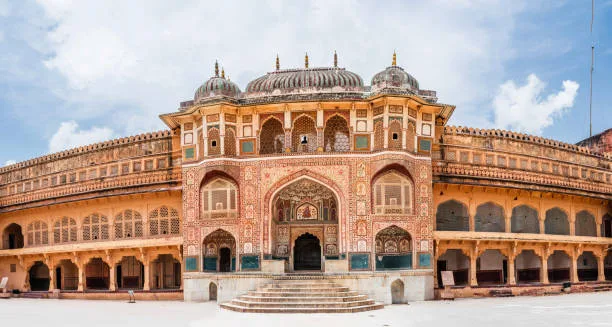
Ganesh Pol is an exquisitely decorated gateway that leads to the royal quarters. It is adorned with vibrant frescoes of Lord Ganesha, the remover of obstacles. As you pass through the gate, you’ll feel like entering a different world—one of royal splendor and opulence.
Jaleb Chowk
Jaleb Chowk is the first courtyard where soldiers assembled for victory parades. The large open space surrounded by ornate arches gives visitors a sense of the scale of the fort’s grandeur.
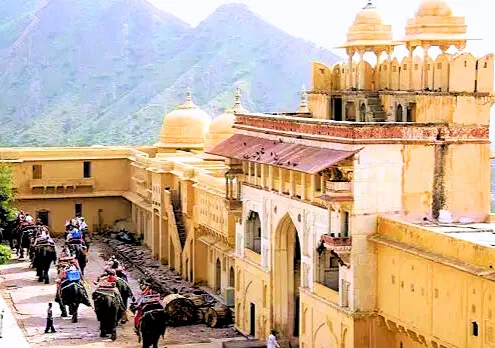
Sheesh Mahal
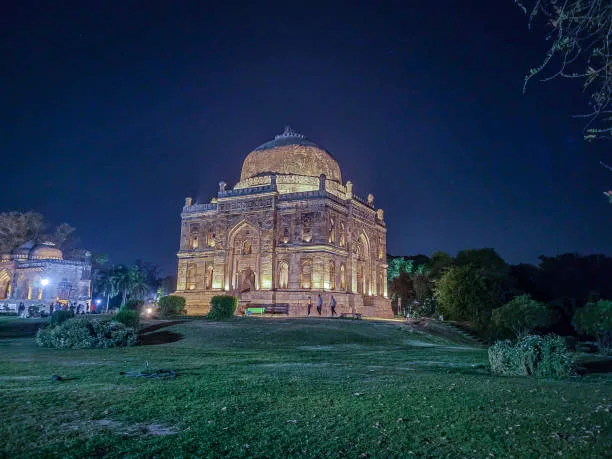
The Sheesh Mahal is perhaps the most mesmerizing part of Amber Fort in India. This “Palace of Mirrors” is adorned with countless small mirrors embedded in the walls and ceiling. When a single flame is lit inside, the reflections create the illusion of a starry sky, giving visitors an unforgettable visual treat.
Sila Devi Temple
Dedicated to Goddess Kali, this temple was where the Maharajas performed animal sacrifices before battles. The intricate silver doors and religious significance make it a key attraction within the fort.
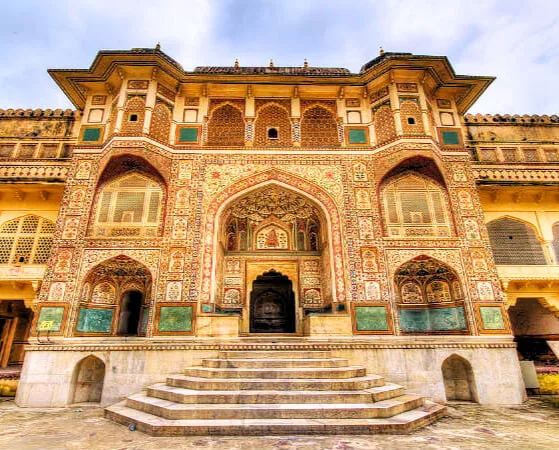
4. Light and Sound Show at Amber Fort in India
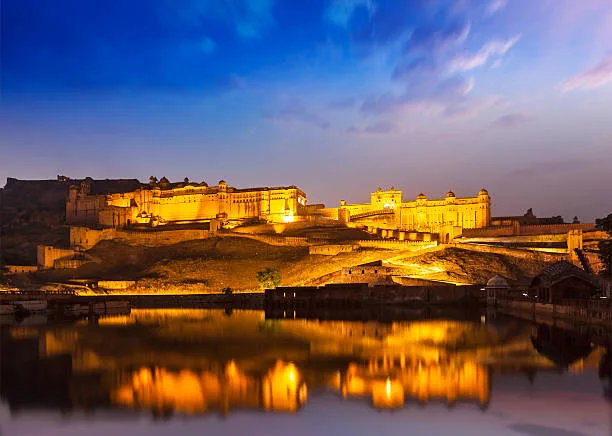
Amber Fort in India becomes even more enchanting during the evening, thanks to the spectacular light and sound show, which is a highlight for visitors. This immersive experience narrates the fort’s rich history, culture, and legends using vibrant lights, captivating sounds, and dramatic effects that bring the fort’s storied past to life. As the illuminated Amber Fort in India glows against the night sky, its reflection in the serene waters of Maota Lake creates a breathtaking and magical sight. Attending this show is a perfect way to experience the beauty and grandeur of Amber Fort in India in a whole new light, making it an unforgettable part of your visit.
Timing:
- Hindi show: 7:30 PM
- English show: 8:30 PM
Ticket price: ₹200 (INR) per person.
5. Elephant Rides and Cultural Experiences at Amber Fort in India
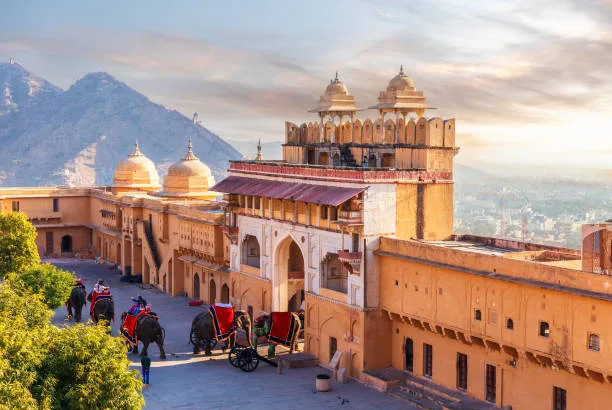
One of the most popular attractions at Amber Fort is the elephant ride up to the fort’s main entrance. As you ascend on a royal elephant, you’ll get a panoramic view of the surrounding landscapes, making the journey even more memorable.
Beyond the elephant ride, Amber Fort offers cultural performances, including traditional Rajasthani folk music and dance. You can also explore local craft shops where artisans demonstrate ancient techniques of block printing and pottery making.
Note: Elephant rides are subject to ethical considerations, so travelers are advised to research before participating.
6. Practical Travel Tips for Visiting Amber Fort in India
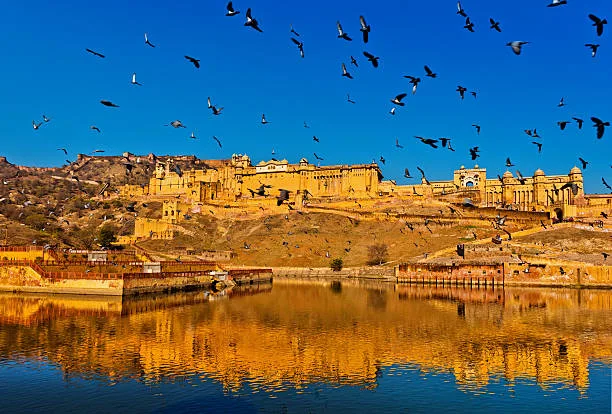
To make the most of your visit to Amber Fort in India, here are some practical travel tips:
- Best Time to Visit: The best time to visit Amber Fort is from October to March, when the weather is pleasant and comfortable for exploring.
- Timings: Amber Fort is open to visitors from 8 AM to 6 PM.
- Entry Fees:
- Indian Nationals: ₹100 (INR)
- Foreign Tourists: ₹550 (INR)
- Guided Tours: Hiring a local guide is highly recommended to fully understand the history and significance of each section of the fort.
- What to Wear: Comfortable footwear is a must, as you’ll be walking on uneven terrain. Carry a hat and sunglasses if visiting during the day.
7. How to Reach Amber Fort in India
Amber Fort in India is located about 11 kilometers from the city center of Jaipur and is well-connected by road. Here are the transportation options:
- By Car/Taxi: Taxis and rental cars are widely available from Jaipur. The fare for a round trip from Jaipur city center to Amber Fort ranges from ₹500 to ₹1000 ($6 to $12 USD).
- By Bus: Regular buses operate from Jaipur to Amber Fort. A ticket costs around ₹20 (INR) per person.
- By Rickshaw: Auto-rickshaws are also an affordable way to reach the fort. Expect to pay around ₹200 (INR) for a one-way trip.
LOCATE AMBER FORT ON MAP
Conclusion: Amber Fort in India – A Timeless Journey into Royal Grandeur
Amber Fort in India is more than just a historical monument; it’s a living testament to the country’s rich royal legacy and an architectural marvel that stands proudly as a symbol of Rajasthan’s regal heritage. The grandeur of Amber Fort in India—from its awe-inspiring architecture, intricate carvings, and expansive courtyards, to the enchanting Sheesh Mahal—offers a fascinating window into the opulence of India’s royal past. Visiting Amber Fort in India is not just a journey through history; it’s an immersive experience that transports you back to the era of kings and queens, showcasing the extraordinary craftsmanship that has endured for centuries.
Whether you’re a history lover, architecture enthusiast, or a curious traveler, Amber Fort in India promises an unforgettable exploration of India’s royal culture and artistic mastery. As you walk through its majestic halls and admire its intricate details, you’ll witness firsthand the legacy of a fort that continues to captivate millions worldwide. Amber Fort in India is truly a crown jewel of Indian heritage, making it a must-see destination for anyone seeking to uncover the essence of India’s royal legacy.
FAQs
Q1: What is the significance of Amber Fort in India?
Amber Fort in India is a symbol of Rajputana grandeur, representing the royal heritage of the Rajput Maharajas. Its blend of Mughal and Rajput architecture, intricate mirror work, and historical significance make it a must-visit destination for history and architecture enthusiasts.
Q2: What are the opening hours of Amber Fort in India?
Amber Fort in India is open from 8:00 AM to 6:00 PM daily. The light and sound show runs in the evening.
Q3: What is the best time to visit Amber Fort in India?
The best time to visit Amber Fort in India is between October and March, as the weather is cool and comfortable for exploring the fort.
Q4: How much time should I spend at Amber Fort in India?
On average, visitors spend 2-3 hours exploring the fort’s different sections, but you could easily spend half a day if you want to take in the cultural performances and the light and sound show.
Q5: Is photography allowed inside Amber Fort in India?
Yes, photography is allowed inside Amber Fort in India, and the fort’s stunning architecture makes it a favorite spot for photographers.
Explore More on Xplro.com
For more immersive travel experiences across India, explore other regal destinations like Jaipur’s City Palace, the magnificent Udaipur, and the legendary Mehrangarh Fort in Jodhpur. Xplro.com provides you with expertly curated travel itineraries and insider tips to make your journeys extraordinary. Dive into India’s architectural wonders and cultural treasures with our detailed travel guides today!


